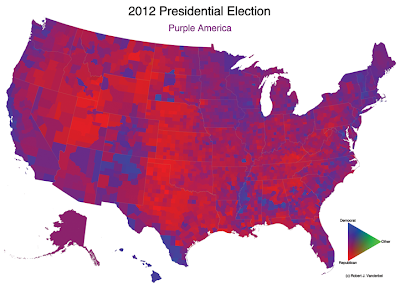Mapping
...
Long time readers of this blog might have noticed that I find maps really fascinating. Here are two that caught my fancy. (These may not display properly in all browsers. My apologies.)
A Princeton map of the 2012 United States presidential election results, showing a more subtle break-down of voting. I find it interesting to see the shades of purple, and not just the blue-versus-red graphics. The places where you can see the demarcation of states is particularly fascinating -- look at the Eastern edge of California, for example.
And another map, showing change over time. In this case, there's a third color in the mix. Green indicates voting for a third party.
Here's how I understand these breakdowns of years where third-party candidates played a significant role (please correct me if I'm wrong).
1968 Richard Nixon (R) narrowly defeats Hubert Humphrey (D). Many Southern Democrats vote for George Wallace (American Independent Party) instead of Humphrey
1980 Bill Clinton (D) defeats President George H. W. Bush (R). Ross Perot runs a strong race, as a Reform Party candidate.
2000 George W. Bush (R) wins a disputed election, defeating Al Gore (D). Many believe that votes for Green Party candidate Ralph Nader might have otherwise gone to Gore.
I'd be really interested in hear blog readers thoughts on the two-party system that we have in the US. (And I trust everyone to find that sweet spot, where the discussion is thought provoking without being rude.) Personally, I'm always interested in multi-party systems where, in order to function, politicians must build coalitions between disparate parties. Considering the vast range of political ideologies in the United States, I'm somewhat surprised that we don't see more independent politicians.
Long time readers of this blog might have noticed that I find maps really fascinating. Here are two that caught my fancy. (These may not display properly in all browsers. My apologies.)
And another map, showing change over time. In this case, there's a third color in the mix. Green indicates voting for a third party.
Here's how I understand these breakdowns of years where third-party candidates played a significant role (please correct me if I'm wrong).
1968 Richard Nixon (R) narrowly defeats Hubert Humphrey (D). Many Southern Democrats vote for George Wallace (American Independent Party) instead of Humphrey
1980 Bill Clinton (D) defeats President George H. W. Bush (R). Ross Perot runs a strong race, as a Reform Party candidate.
2000 George W. Bush (R) wins a disputed election, defeating Al Gore (D). Many believe that votes for Green Party candidate Ralph Nader might have otherwise gone to Gore.
I'd be really interested in hear blog readers thoughts on the two-party system that we have in the US. (And I trust everyone to find that sweet spot, where the discussion is thought provoking without being rude.) Personally, I'm always interested in multi-party systems where, in order to function, politicians must build coalitions between disparate parties. Considering the vast range of political ideologies in the United States, I'm somewhat surprised that we don't see more independent politicians.



Comments